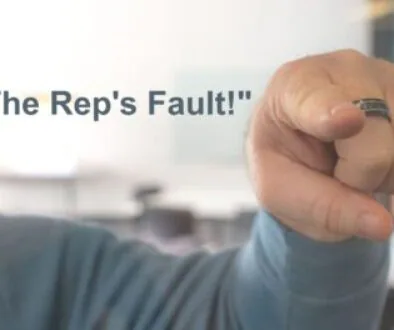In Healthcare, failure is a dirty word. How do you sell a product that is associated with failure?
It can be difficult to sell a technology, procedure, or product that is similar to one with past failures. Salespeople hate this scenario, especially in healthcare where failure is a dirty word. But what if you have a product or service that you know works and the customer believes otherwise. How do you change the customer’s perception?
It starts with your own personal belief and passion. When you know you’re offering the right product or service for the patient and the provider, nothing can stop you. Let me give you an example.
Back around 1990-93 (the olden days for some of you!) I was given a unicompartmental knee to sell. Asking an orthopedic surgeon to implant a uni knee during this time was like asking an infectious disease specialist to use leeches to treat tuberculosis—the conventional wisdom was that unicompartmental knees don’t work, in fact, they failed quickly and miserably!
When I first approached orthopedic surgeons regarding unicompartmental knees, they responded in disbelief or anger. “You want to talk about unicompartmental knees? Are you kidding me? I would never use a uni knee!” Had I not been prepared, I would have left the office and probably not been allowed back. But I had a great story to tell and I believed with everything in me that every knee surgeon needed to hear it.
Sales training on the new unicompartmental knee included a day with an orthopedic surgeon who practiced in a farming region in the Midwest. He had implanted hundreds of the new unicompartmental knees over a three year period with exceptional results and it was making a huge difference in people’s lives. I learned in detail how this knee design was different from those that failed and also how the surgical technique and patient selection criteria were vastly different. What really stood out for me were the testimonials of patients who were far happier than patients who had total knee replacement.
I can’t give you the entire sales approach here, but I always handled the “uni knees are crap” objection by acknowledging the doctor’s perception. “I understand. The high failure rate associated with previous designs is reason to be cautious. But if some of your colleagues are getting better results with unicompartmental knees than they are with total knees, isn’t this something you should at least know about ?”
After sharing the rural surgeon’s success stories and how he selected patients, I presented the clinical data in two journal articles and several white papers. I made sure that the surgeon understood why uni’s failed in the past and how the new implant design and instrumentation favored success. A demonstration of the simplified surgical technique that supported sound biomechanical principles led to the next step, which was an invitation to do a mock procedure on sawbones (plastic bones that cut similar to real bone). Many of the surgeons were convinced to give the uni a try, especially since they could easily switch to a total knee at the time of surgery if they were not satisfied with how the uni functioned.
After the patients returned to the surgeon’s office for follow-up, my business was locked in. The patients recovered much faster than those with total knees and they said that the knee essentially felt like their natural knee (something you don’t hear about total knees). But something even better was happening—patients were telling their friends about this “new knee” and it was driving referrals to the doctors’ offices. I became credible by “selling” customers something they would never have considered on their own and making them heros to their patients.
Steve Jobs used to say that people don’t know what technology they need. No one really wanted a tablet computer. They had been available for years and never really caught on. This changed when Jobs sold them the iPad. Imagine that…a product that no one wanted became one of the most successful products in history because Steve Jobs sold it to people who were telling him “no.”
If you’re convinced you have a better product that can improve the patient’s and the provider’s condition, don’t let a customer’s negativity stop you from doing the right thing. You must be prepared to overcome all of the objections and follow-up until the customer says yes. But it all starts with your own passion—do you believe in what you’re selling, or are you just trying to make a sale?



@ 12:04 pm
Great story! Thanks!